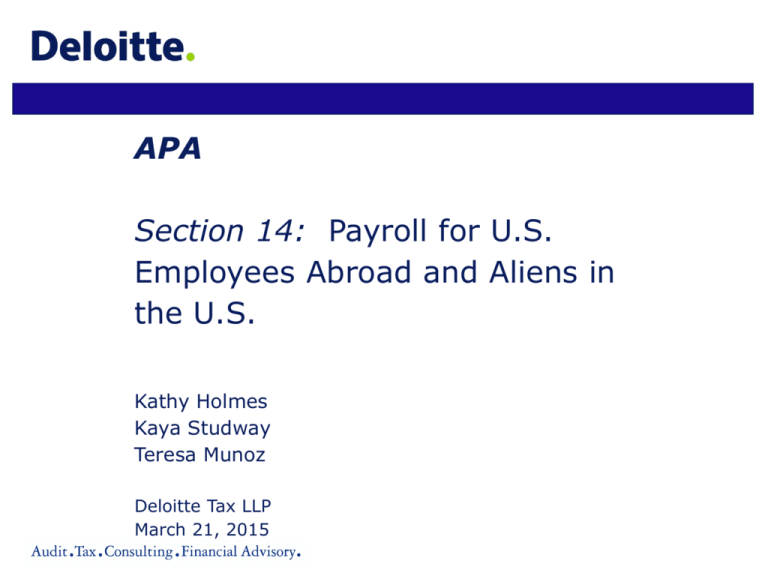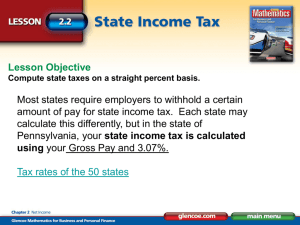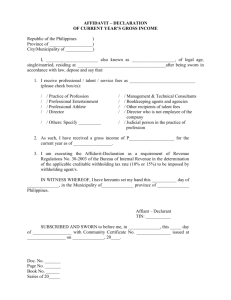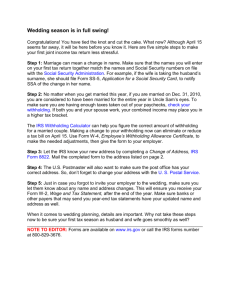
APA
Section 14: Payroll for U.S.
Employees Abroad and Aliens in
the U.S.
Kathy Holmes
Kaya Studway
Teresa Munoz
Deloitte Tax LLP
March 21, 2015
Session Agenda
•
Expatriates - US Citizens or Resident Aliens Working Abroad
Expatriate Payroll
Tax Equalization and Tax Protection
U.S. Foreign Earned Income Exclusion/Credits
Income Tax Treaty Agreements
U.S. Reporting and Withholding Requirements: Federal, State, Social Security and
Medicare
Earnings Adjustments and Tax Gross-Up/Tax Gross-Down
•
Inpatriates -Residents or Non-Resident Aliens Working in the U.S.
Tax Equalization and Tax Protection
U.S. Resident/Nonresident Alien Status
Visas
Payroll Documentation and U.S. Reporting/Withholding
U.S. Resident Aliens
U.S. Nonresident Aliens
Earnings Adjustments and Shadow Payroll
•
U.S. Social Security Totalization Agreements
2
Expatriate Payroll
Allowances and Reimbursements
•
Rules regarding U.S. compensation reporting and tax withholding for U.S. citizens,
permanent residents and employees working outside of the U.S. are more complex and
require coordination among various departments within an organization.
•
U.S. companies who employ U.S. citizens or permanent residents abroad must
report their compensation on a U.S. Form W-2.
•
U.S. companies sending employees to work abroad may have an international
assignment policy in place to ensure that the employee receives total compensation
that will provide for a standard of living comparable to what he/she would have had if
he/she remained living and working in the U.S.
•
This policy may provide for regularly paid allowances and/or reimbursements for
the cost of various benefits to ensure that the employees do not suffer or benefit
financially in comparison to his/her U.S. counterparts.
•
Depending on the reason or need for the assignment, additional incentives may also be
included in an individual’s assignment package.
3
Expatriate Payroll
Components of Compensation
• Examples of allowances and reimbursements include:
Host country housing and utilities allowance/differential
Goods and services differential (also referred to as a cost of living allowance)
Auto allowance or lease payments
Education allowance or reimbursement for children’s education expenses
Transportation expenses to/from the host location
Shipment and/or storage of household goods
Periodic home leave travel expenses
Location/hardship premiums
International assignment premiums
Host country taxes
Professional fees (i.e., tax preparation services)
4
Expatriate Payroll
Allowances/Reimbursements
How are these allowances/reimbursements paid?
•
Assignment related allowances/reimbursements may be paid from various
sources:
-
Home Country Payroll
- Host Country Payroll
- Treasury
- Accounts Payable
- Third Party Vendors
- Host Country Accounts Payable
- Imputed Income
•
Additional payroll codes or “buckets” may be necessary to deliver allowances
or reimbursements via payroll.
5
Expatriate Payroll
Allowances/Reimbursements
Why is it necessary to know about these payments?
•
Any allowances or reimbursements that an expatriate receives (either in
cash or in kind) from his/her employer may be considered compensatory
and/or taxable in the U.S.
This would not apply to most items of compensation received by individuals on
temporary or short-term international assignments (i.e., assignments under 12
months)
•
These allowances and/or reimbursements may need to be added to the
employee’s total compensation and reported on a Form W-2.
•
Assignment related allowances and/or reimbursements included in
compensation often result in Form W-2 wages of 2-3 times the employee’s
pre-assignment reportable wages.
•
The additional compensation often triggers additional tax obligations.
•
In most cases, the incremental tax obligations are borne by the employer.
6
Expatriates
Tax Equalization and Tax Protection Policies
•
Many employers follow a policy of Tax Equalization
Tax Equalization is designed to ensure that the tax impact to an employee of
taking an international assignment is neutral – the employee will pay no
more or no less tax than they would have if they had remained in their home
country.
•
Some employers follow a policy of Tax Protection
Tax protection is designed to ensure that the employee pays no more tax
than they would had they remained in their home country; however, if the
actual tax liability is less than what the employee would have paid had
he/she remained in their home country, the employee retains the benefit.
7
Expatriates
Hypothetical Tax
• Hypothetical tax represents the home country tax that the employee would
have paid had he/she remained in the home country.
• Hypothetical tax is typically withheld from the employee in lieu of actual tax
(i.e., federal income tax).
• In addition to hypothetical federal tax, the employer may take a hypothetical
state tax depending on the terms of the international assignment and tax
reimbursement policies.
• Hypothetical tax is treated as a REDUCTION to earnings and reduces the
federal and Social Security/Medicare wages reported on an employee’s Form
W-2.
8
Expatriates
U.S. Foreign Income Exclusions/Credits
•
Expatriates may qualify for exclusions to taxable income and tax credits which will reduce
the actual tax liability on their U.S. income tax return.
•
To the extent it is believed that the employee will qualify for these reductions and credits,
U.S. federal income tax withholding obligations can be reduced and/or eliminated.
Exclusions
Foreign Earned Income Exclusion ($99,200 for 2014) – Form 2555
Bona Fide Resident (Tax home outside U.S. for entire calendar year)
Physical Presence (Physically present outside U.S. for 330 days in a 365 day
period)
Housing Exclusion
Qualified foreign housing expenses are approximately $13,888 for 2014
(30% of the Foreign Earned Income Exclusion less base housing amount)
May be higher in “expensive housing” locations
–
Some expenses are excluded from definition of “qualified foreign housing
expenses” (i.e., personal telephone, cable, furniture, domestic labor)
Credits:
Foreign Tax Credits
Other Normal Credits (i.e., childcare credit, AMT, etc.)
9
Expatriates
Determining the Source of Earned Income
•
Source of earned income is determined by where the employee performed the
services that produced the income.
•
Generally the following formula is used to determine the portion allocable to
the U.S.:
Number of days worked in the US
X
Total income
= U.S. Source Income
Total number of days worked
Example
Jane, a U.S. citizen, is a bona fide resident of Canada. Jane’s total income is $90,000 and worked
for a total of 240 days after subtracting vacation time. She worked 30 days in the U.S. during the
year. What is Jane’s U.S. sourced income?
30 days worked in the U.S.
X
$90,000
= U.S. Source Income of $11,250
240 total days worked
•
Jane’s foreign earned income= $90,000- $11,250 = $78,750
10
Expatriates
Foreign Housing Exclusion
•
Foreign Housing Exclusion
Example
Jane, a U.S. citizen, qualifies for the foreign earned income exclusion for 2014 under the physical
presence test
During the 2014 year she earned a salary of $75,000 and was present and working in the foreign
country for 335 out of 365 days
Jane spent $15,000 on reasonable foreign housing expenses
What is Jane’s base housing amount for 2014 ?
Annual base housing amount for 2014 = $15,872
Prorated base housing amount for foreign days in 2014 = $15,872 * (335/365) = $14,567
What is Jane’s foreign housing cost exclusion for 2014 ?
Reasonable housing expenses – Base housing amount = Foreign housing cost exclusion
$15,000 - $14,567 = $433
11
Expatriates
Income Tax Treaty Agreements
• Income tax treaty benefits may include:
Credits and deductions to reduce taxes imposed by the foreign country
(i.e., to avoid double taxation)
Nondiscrimination clauses allowing resident aliens (Green Card holders)
to qualify for the foreign earned income and housing cost exclusions
under the bona fide residence or physical presence test
Partial or total exemption from taxation by the foreign country for an
employee’s wages for personal services performed in the treaty country
Wages received by a U.S. teacher or professor in a treaty country are
exempt from foreign taxes under most treaties for up to 2-3 years
Amounts received by U.S. residents for study, research, or business and
technical training are generally exempt from foreign taxes
12
Expatriates
Reduction in Federal Income Tax Withholding
If the individual is…
•
Subject to mandatory withholding in foreign country => automatically
exempt, no documentation required.
•
Will qualify for foreign earned income and/or housing exclusions => can
reduce income subject to withholding by the amount of income that will be
excluded on income tax return, must have Form 673 completed and on file
for first two years individual qualifies for exclusions.
•
Will be able to claim foreign tax credits => can reduce income subject to
withholding by amount of income that generates a U.S. income tax liability
due to foreign tax credits, must have Form W-4 completed and on file
documenting additional withholding exemptions.
After all is said and done, there may still be a residual income tax withholding
obligation for expatriates!
13
Expatriates
U.S. State Reporting and Withholding Requirements
•
State compensation reporting and tax withholding requirements will vary based on the
state of domicile/residence before the assignment begins.
•
The state of domicile/residence must be determined.
Domicile – factors used to determine:
Where the employee intends to return
State issuing the employee’s drivers license
Where the employee votes
Residence – factors used to determine:
Where employee is physically present
Where immediate family lives and where children attend school
Where the employee works
•
Certain states will allow the individual to break residency, resulting in no actual state
taxation while on international assignment (e.g., Illinois).
•
In situations where state residency may be broken, state wages should not accumulate
for the period in which the employee was considered to be in non-resident status;
provided the wages are not sourced to a state.
•
In some states it is very difficult to break state residency (e.g., New York) and state
wages may need to continue accumulating as an individual typically continues to be
taxed as a resident while on international assignment.
•
Rules should be reviewed on a state by state basis.
•
In addition, some states (e.g., North Carolina) will recognize foreign tax credits and if
residency cannot be broken, tax withholding may be able to be reduced during an
international assignment.
14
Expatriates
U.S. FICA Reporting and Withholding Requirements
• FICA wages include compensatory allowances and/or reimbursements,
employer-paid individual taxes, net of hypothetical tax withholding.
• Assignment related allowances and/or reimbursements included in
compensation often result in Form W-2 Social Security and Medicare wages
of 2-3 times the employee’s pre-assignment reportable wages.
• In general, these wages are subject to standard U.S. Social Security and
Medicare tax withholding.
• Exclusions and/or credits allowable for federal income tax purposes do not
apply to Social Security and Medicare tax withholding requirements.
15
Expatriates
Earnings Adjustment
• All allowances and/or reimbursements paid outside of the normal payroll
process should be collected and reviewed to determine if the amounts are
compensatory.
• Since U.S. citizens and permanent residents are taxed in the U.S. on
worldwide income, all elements of company paid compensation should be
considered regardless of the source of the payment.
• Certain reimbursements may be excluded from wages based on IRS rules.
Factors to consider include:
Intended length of the assignment
Nature of the payment
Form of the payment
Policy provisions
• Certain relocation expenses may be excludable but reportable in
Box 12 Code P of Form W-2.
16
Expatriates
Tax Gross-up
• Generally a tax gross-up will be calculated to account for the additional
federal, state, local and/or social taxes that may be associated with the
assignment related compensation elements that are being added to the
employee’s taxable wages.
• An adjustment should be made to the employee’s wages and withholdings
to add the additional compensation elements as well as the tax withholding.
• The tax gross-up should be paid to the appropriate tax authority as
withholding on behalf of the employee and reported on Form W-2.
17
Expatriates
Example of an Incorrect Tax Gross-up
•
Tax Gross-up - common mistake
Net payment = $50,000
Tax rate = 20%
- 50,000 * 20% = 10,000 … additional tax of $10,000
- Company pays tax of $10,000, so gross payment is $60,000
- Employee should pocket $50,000, but receives $2,000 less than intended
$60,000 * 20% = $12,000
$60,000 - $12,000 = $48,000
Calculation doesn’t work!
18
Expatriates
Example of a Correct Tax Gross-up
• Tax Gross-up – correct calculation
Net Payment
=
Gross Amount
(1-Tax Rate)
Net payment = $50,000
Tax rate = 20%
- 50,000/ (1-.20) = $62,500
- Additional tax of $12,500 = $62,500 * .20
- $62,500 – 12,500 = $50,000
Calculation works!
19
Expatriates
Tax Gross-Down
•
In some situations earnings may be adjusted by reducing income for
assignment related payments that an employee paid back to the company.
• This may result in the need for a tax gross-down which will reduce the amount
of the tax payments reported on the W-2.
•
The application of the reduction and the gross down will depend on the
company’s international assignment policy.
20
Expatriates
Form W-2 Reporting for Earnings Adjustments
• Earnings adjustment for assignment-related compensation:
Federal wages = include
Medicare wages = include
Social Security wages = include to the extent that the employee has not reached
the maximum wage base ($117,000 for 2014; $118,500 for 2015)
State/local wages = include only if the employee is considered a resident of that
state/locality
• Tax gross-ups should be included in the appropriate tax withholding box
• In general, expatriates will have an earnings adjustment for each year of the
assignment and typically for an additional one to three years beyond
repatriation.
21
Expatriates
Earnings Adjustment Example - Gross-up Calculation
• Base Wages (without assignment income) = $205,000
• Add company paid benefits:
Host Housing
$ 60,000
Auto Assistance
$ 20,000
Education Assistance
$ 30,000
$110,000
• Gross Up Rates
Federal
28.00%
State*
5.00%
Medicare
1.45%
Additional Medicare
.9%
1
x
110,000 = $170,146.95
(1 - .28 - .05 - .0145 -.009)
Total Additional Compensation = $170,146.95
*Assumes earnings adjustment occurs while the individual is a state tax resident.
22
Expatriates
Earnings Adjustment Example - Gross Up Breakdown
EXAMPLE
• Breakdown of tax gross-up
$170,146.95 * .28 = $47,641.15 = Federal Taxes
$170,146.95 * .05 = $8,507.35 = State Taxes
$170,146.95 * .0235 = $3,998.45 = Medicare Taxes
Total Taxes
=
$ 60,146.95
Total Allowances=
$110,000.00
Total Adjustment=
$170,146.95
23
Expatriates
Earnings Adjustment Example – W-2 Adjustments
• Adding it to Form W-2 wages
Box 1 Federal Wages:
$ 170,146.95
Box 2 Federal Taxes:
$
47,641.15
Box 3 Social Security Wage *:
$
0
Box 4 Social Security Tax *:
$
0
Box 5 Medicare Wage:
$ 170,146.95
Box 6 Medicare Tax:
$
Box 16 State Wage:
$ 170,146.95
Box 17 State Tax:
$
3,998.45
8,507.35
new cost
new cost
new cost
* Assumes annual Social Security maximum has already been met.
24
Expatriates
Treatment of Additional Employer Costs
• Hypothetical tax withholding is generally used to help offset incremental
assignment related costs.
• Adjustments to earnings are payments that have already been made and
therefore most likely have been accounted/accrued for by the paying party.
• Tax gross-ups are new payments that have often not been
accounted/accrued for by the paying party.
• Generally tax gross-ups are charged to the cost center bearing the cost of the
assignment, while hypothetical taxes are credited to that cost center.
25
Inpatriates
26
Inpatriates
Tax Equalization and Tax Protection Policies
• Just as with expatriates, inpatriates will generally be covered by a company
International Assignment Policy to alleviate any financial or tax burden as a
result of accepting the international assignment.
• Inpatriates may be covered under a policy of tax equalization or tax
protection.
• The inpatriate may be responsible for paying their own U.S. taxes.
• Inpatriates covered by a certificate of coverage should not be subject to
Social Security and Medicare tax.
27
Inpatriates
U.S. Resident/Nonresident Alien Status
• Determining U.S. Resident and Nonresident Alien Status
U.S. Resident: meets lawful permanent resident test or substantial presence test
Lawful permanent resident – “green card” test
Substantial presence test
Present in the U.S. for at least 31 days in the current calendar year; and
Total U.S. days of presence meet or exceed 183 days counting:
–
Total U.S. days in current calendar year, plus
–
1/3 U.S. days in first preceding calendar year, plus
–
1/6 of U.S. days in second preceding calendar year
Nonresident aliens taxed on U.S. sourced income, with exceptions
• Business Travelers
May be exempt from U.S. federal income tax withholding if:
Nonresident alien is in the U.S. for 90 days or less during the tax year; and
Compensation received for U.S. services does not exceed $3,000 during the tax year; and
Nonresident alien is employed by foreign employer, or a U.S. employer in a foreign country
28
Inpatriates
Visas
• Immigrant Visa – I-551
Permanent Resident Card (i.e., green card)
• Most common nonimmigrant visas include:
B-1: Visitors for business
Students, workers, or foreign press being paid by a foreign employer
H-1B: Professional and technical workers
College-educated or experienced professionals
J-1: Exchange visitors
Students, trainees, and teachers in the U.S. to participate in an exchange program
Federal income tax withholding exemptions available
Exempt from social wage reporting and withholding
L-1 (A and B): Intracompany transfers
Executives or professionals with specialized knowledge
F-1: Students
Full-time students at an approved U.S. educational institution
Federal income tax withholding exemptions available
Exempt from social wage reporting and withholding
29
Inpatriates
Payroll Documentation and Reporting/Withholding
•
Inpatriates should obtain a U.S. social security number (SSN) or ITIN
(Individual Taxpayer Identification Number).
•
ITIN numbers begin with a 9 (no SSNs start with a 9)
•
ITINs expire after 5 years
•
Application process can be arduous
•
Inpatriates should complete a Form W-4, Employee’s Withholding Allowance
Certificate, and Form I-9, Employment Eligibility Verification.
•
Wages paid to and taxes withheld from inpatriates must be deposited and
reported by the employer in the same way it does for all other employees,
using Form 941 and Form W-2.
30
Inpatriates
Reporting and withholding for U.S. resident aliens
• In general, U.S. resident aliens are subject to the same U.S. federal, state
and unemployment tax reporting and withholding obligations as U.S.
citizens/permanent residents.
• Employers must report compensation and withhold federal, state, local and
social tax (also state disability and unemployment taxes where required).
• Employers must also fund the employer portion of Social Security, Medicare,
and federal and state unemployment taxes.
• In general, federal unemployment (FUTA) applies to all wages paid for work
performed in the U.S. regardless of the citizenship or residency status of the
employee or the employer.
31
Inpatriates
Reporting and withholding for U.S. nonresident aliens
•
In general, U.S. nonresident aliens are subject to the same U.S. federal, state and
unemployment tax reporting and withholding obligations as U.S. residents.
•
If an income tax treaty applies, the nonresident alien employee may be exempt
from U.S. income tax withholding on wage income
Form 8233 must be provided to the employer for the income tax withholding
exemption to apply
Form 8233 should be mailed by the employer to the IRS within 5 days of receipt
A copy must be given to the employee upon submission
•
Forms 1042 are required for reporting of US sourced non-wage payments and tax
withholding made to non resident aliens and not reported on Form W-2
Form 1042 – Payer reporting form
Must be paper filed
Form 1042-S - Payer required form to provide to the payee
If payer files 250 or more Forms 1042-S, they are required to be submitted
electronically
Form 1042-T – Form to be sent with the paper Form 1042-S
Only required if filing a paper form
All forms due by March 15th following the close of the tax year
32
Inpatriates
Income Tax Withholding Calculation for Nonresident Aliens
•
Special procedure required to calculate Federal income tax withholding for
nonresident alien employees
•
The income tax to be withheld is determined by applying the withholding
tables to the sum of the wages paid for the payroll period plus the additional
amount below:
2015
33
Inpatriates
Earnings adjustments and shadow payroll
• While the inpatriate may continue to be paid in his/her home country, wages
received for work performed in the U.S. should be reported in the U.S. and
the appropriate taxes should be paid to the appropriate tax authority on
Form W-2.
• The assignee may also receive other company paid benefits.
• An earnings adjustment may be required (as with an expatriate) to ensure
proper reporting and withholding on Form W-2.
• Where taxes are paid on behalf of the assignee by the company, a tax grossup will be added to the individual’s compensation each pay period to result in
a neutral net effect to the employee.
34
Inpatriates
Reporting Monthly Pay in U.S. – Shadow Payroll Example
Monthly Base Pay in UK = GBP 5,000
Converted @ 1.5 = $7,500
Federal Taxes = $1,875
State Taxes = $375
Monthly Pay = $9,750
Less: Federal Taxes <$1,875>
Less: State Taxes <$375>
Less: Pay Received in UK <$7,500>
Net Pay in U.S. = $0
(In this example, no Social Security or Medicare taxes are paid due to Totalization
Agreement)
35
Totalization Agreements
36
U.S. Social Security Totalization Agreements
• While living and working outside the home country, assignees may become
subject to host country social tax.
• In order to eliminate the burden of double social tax, the U.S. government
has entered into bi-lateral social security totalization agreements with 25
countries.
• Obtaining coverage under a totalization agreement alleviates the need to
contribute to host country social system. The employee continues to
contribute to the home country social system where they will ultimately
obtain a social security benefit.
• Certificates of coverage under a social security totalization agreement can be
applied for via the U.S. social security administration website:
http://www.ssa.gov/international
• In general, certificates of coverage are effective for 5 years (with the
exception of Italy (unlimited) and Germany (9 yrs).
37
Totalization Agreements
List of U.S. agreements
Australia
Japan
Austria
Luxembourg
Belgium
Netherlands
Canada
Norway
Chile
Poland
Czech Republic
Portugal
Denmark
Slovak Republic
Finland
Spain
France
South Korea
Germany
Sweden
Greece
Switzerland
Ireland
United Kingdom
Italy
38
Questions?
Copyright © 2015 Deloitte Tax LLP. All rights reserved.
39




